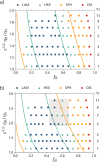Phase Behavior and Conformational Asymmetry near the Comb-to-Bottlebrush Transition in Linear-Brush Block Copolymers
- PMID: 38495384
- PMCID: PMC10938885
- DOI: 10.1021/acs.macromol.3c02180
Phase Behavior and Conformational Asymmetry near the Comb-to-Bottlebrush Transition in Linear-Brush Block Copolymers
Abstract
This study explores how conformational asymmetry influences the bulk phase behavior of linear-brush block copolymers. We synthesized 60 diblock copolymers composed of poly(trifluoroethyl methacrylate) as the linear block and poly[oligo(ethylene glycol) methyl ether methacrylate] as the brush block, varying the molecular weight, composition, and side-chain length to introduce different degrees of conformational asymmetry. Using small-angle X-ray scattering, we determined the morphology and phase diagrams for three different side-chain length systems, mainly observing lamellar and cylindrical phases. Increasing the side-chain length of the brush block from three to nine ethylene oxide units introduces sufficient asymmetry between the blocks to alter the phase behavior, shifting the lamellar-to-cylindrical transitions toward lower brush block compositions and transitioning the brush block from the dense comb-like regime to the bottlebrush regime. Coarse-grained simulations support our experimental observations and provide a mapping between the composition and conformational asymmetry. A comparison of our findings to strong stretching theory across multiple phase boundary predictions confirms the transition between the dense comb-like regime and the bottlebrush regime.
© 2024 The Authors. Published by American Chemical Society.
Conflict of interest statement
The authors declare no competing financial interest.
Figures






Similar articles
-
Side-Chain Density Driven Morphology Transition in Brush-Linear Diblock Copolymers.ACS Macro Lett. 2022 Apr 19;11(4):468-474. doi: 10.1021/acsmacrolett.2c00068. Epub 2022 Mar 21. ACS Macro Lett. 2022. PMID: 35575336
-
Construction of Enzyme-Responsive Micelles Based on Theranostic Zwitterionic Conjugated Bottlebrush Copolymers with Brush-on-Brush Architecture for Cell Imaging and Anticancer Drug Delivery.Molecules. 2022 May 7;27(9):3016. doi: 10.3390/molecules27093016. Molecules. 2022. PMID: 35566368 Free PMC article.
-
Effect of poly[oligo(ethylene glycol) methyl ether methacrylate] side chain length on the brush swelling behavior in A/B/A-B ternary blends with polystyrene.Soft Matter. 2023 Jun 21;19(24):4519-4525. doi: 10.1039/d3sm00151b. Soft Matter. 2023. PMID: 37283286
-
Highly Asymmetric Phase Diagram of a Poly(1,2-octylene oxide)-Poly(ethylene oxide) Diblock Copolymer System Comprising a Brush-Like Poly(1,2-octylene oxide) Block.Macromol Rapid Commun. 2009 Dec 16;30(24):2141-6. doi: 10.1002/marc.200900474. Epub 2009 Nov 4. Macromol Rapid Commun. 2009. PMID: 21638508
-
Application of Bottlebrush Block Copolymers as Photonic Crystals.Macromol Rapid Commun. 2017 Jul;38(13). doi: 10.1002/marc.201700058. Epub 2017 May 22. Macromol Rapid Commun. 2017. PMID: 28544118 Review.
References
LinkOut - more resources
Full Text Sources
